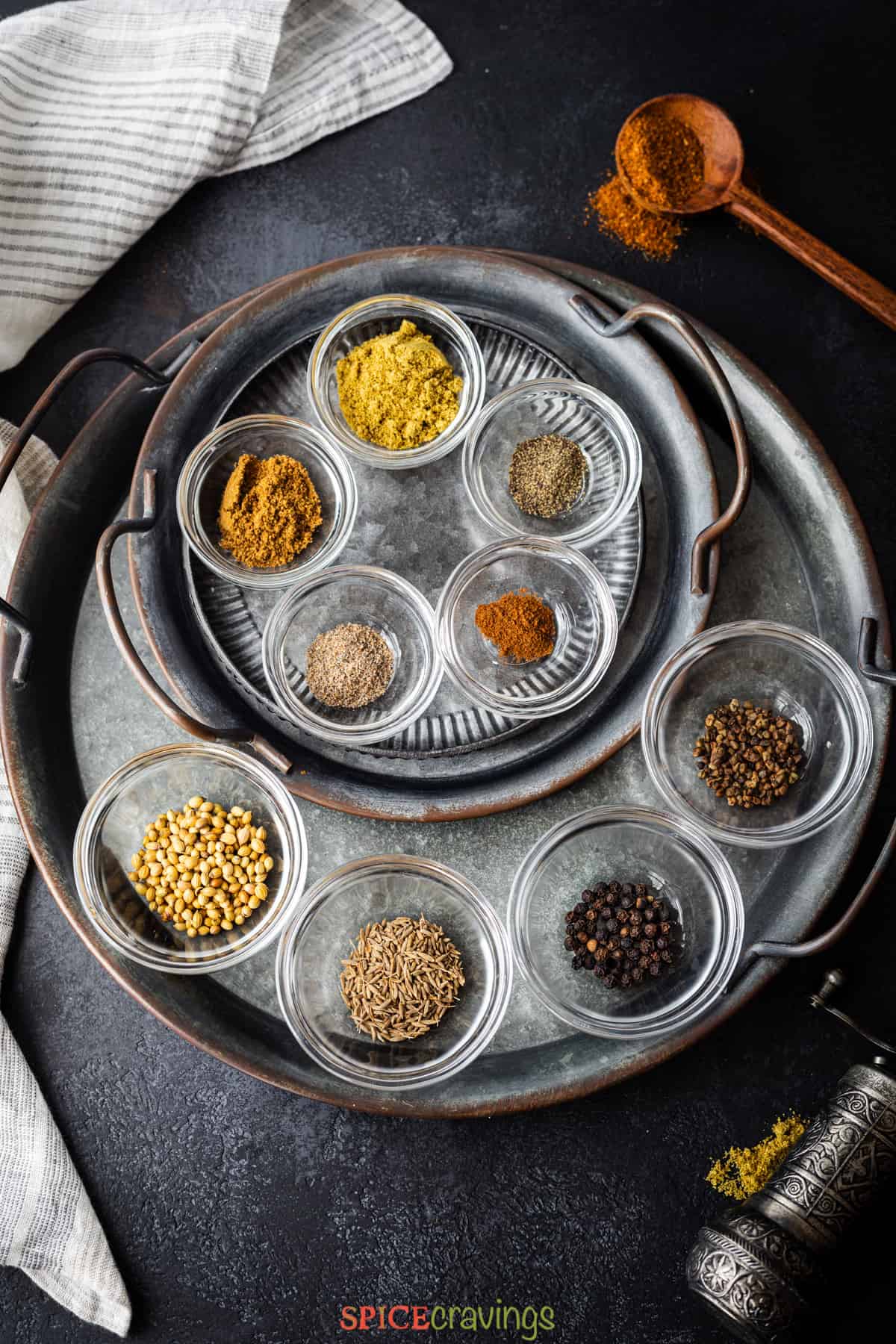Did you know that a pinch of garam masala can elevate your ordinary dish to a whole new level of taste and aroma?
This magical spice blend is a staple in Indian cuisine, but what if you find yourself without it?
Fear not, for we have a list of tantalizing substitutes that can give your dishes a flavorful twist.
From curry powders to exotic blends like ras el hanout, get ready to embark on a culinary adventure!
garam masala substitute
There are several substitutes for garam masala that can be used in Indian cooking.
Some options include curry powder, allspice, a combination of cumin, coriander, and cardamom, five spice powder, ground cloves and cinnamon, chole masala or pav bhaji masala, ras el hanout, chaat masala, and pumpkin spice.
While these substitutes may not exactly replicate the flavor and aroma of garam masala, they can provide a similar warm and aromatic profile to enhance dishes in a pinch.
Key Points:
- Garam masala substitutes include:
- Curry powder
- Allspice
- Cumin, coriander, and cardamom combination
- Five spice powder
- Ground cloves and cinnamon
- Chole masala or pav bhaji masala
- Ras el hanout
- Chaat masala
- Pumpkin spice
- While not identical, these substitutes can provide a similar warm and aromatic profile.
- Curry powder is a popular substitute for garam masala.
- A combination of cumin, coriander, and cardamom can also be used as a substitute.
- Five spice powder, chole masala, pav bhaji masala, ras el hanout, chaat masala, and pumpkin spice are additional substitute options.
- These substitutes can be used in Indian cooking to enhance the flavors of dishes.
garam masala substitute – Watch Video


Pro Tips:
1. Did you know that if you run out of garam masala and need a substitute, you can use equal parts ground cumin, ground coriander, and ground cardamom? This blend is an excellent alternative that will still lend a warm and slightly spicy flavor to your dish.
2. In traditional Indian cooking, garam masala is not always used in every dish. It is often added towards the end of cooking or as a finishing touch since heat can diminish its complex flavor profile.
3. The word “garam” in Hindi translates to “hot,” but it does not refer to the spice’s heat level. Instead, it denotes the warm and comforting sensations the combination of spices in garam masala brings to a dish.
4. Garam masala is not a fixed recipe; there are no universally accepted ingredients or ratios. Instead, it varies across different regions in India and even between households. This diversity allows for individual creativity and experimentation in creating unique spice blends.
5. The use of garam masala goes beyond culinary purposes. In some Ayurvedic practices, it is believed that garam masala aids digestion, promotes a healthy metabolism, and helps balance the body’s internal heat.
Garam Masala Substitute Options
Garam masala is a key ingredient in Indian cuisine, prized for its aromatic and flavorful qualities. Although there are no exact replacements for garam masala, there are a few alternatives that can be used when necessary. While these substitutes may not fully replicate the unique taste of garam masala, they can still enhance the depth and warmth of your dishes. Here are some options to consider:
-
Curry powder: This spice blend shares some similarities with garam masala, as it contains many of the same spices such as cumin, coriander, and turmeric. However, curry powder may have a slightly different flavor profile due to the absence of certain ingredients found in garam masala.
-
Individual spices: If you don’t have garam masala on hand, you can try combining or using individual spices commonly found in the blend. These may include cumin, coriander, cardamom, cinnamon, cloves, and black pepper. Experimenting with different ratios of these spices can help you achieve a flavor profile similar to garam masala.
-
Cumin and coriander: Cumin and coriander are two key spices in garam masala and can be used as a simpler substitute when necessary. While they may not provide the same complexity as garam masala, they can still add a touch of the distinctive Indian flavor to your dishes.
Remember, while these alternatives can work in a pinch, garam masala is truly unique and offers an unparalleled depth of flavor. So, if possible, it’s always best to use the real deal for an authentic Indian culinary experience.
Note: Garam masala is a staple in Indian cooking, known for its rich aroma and complex flavors.
In summary, when you find yourself without garam masala, consider using curry powder, a combination of individual spices, or just cumin and coriander as substitutes. These alternatives may not replicate the exact taste of garam masala, but they can still add depth and warmth to your dishes.
- Curry powder
- Individual spices (cumin, coriander, cardamom, cinnamon, cloves, and black pepper)
- Cumin and coriander
Understanding The Meaning Of Garam Masala
The term “garam masala” translates to “warm spice blend” in English. Contrary to popular belief, garam masala does not contain any chili peppers. It is a combination of various spices that are commonly used in Indian cuisine to enhance the flavors and aromas of dishes.
- Garam masala is a key ingredient in many Indian recipes, adding depth and complexity to the dish.
- The exact composition of garam masala can vary, but it typically includes spices like cumin, coriander, cardamom, cinnamon, cloves, and black pepper.
- Each spice contributes its unique taste and aroma, resulting in a rich and flavorful blend.
- Garam masala is often added towards the end of cooking to preserve the freshness and potency of the spices.
Fun Fact: Garam masala is versatile and can be used in both vegetarian and non-vegetarian dishes, from curries to kebabs.
- Try sprinkling a pinch of garam masala on top of yogurt for a delicious and fragrant snack.
- Adding garam masala to soups or stews can elevate their flavors.
- Garam masala can also be used as a rub for meats or vegetables before grilling or roasting.
Remember, garam masala is a versatile spice blend that adds warmth and depth to Indian cuisine. Its unique combination of spices enhances the flavors and aromas, making it a must-have in any spice collection.
Garam Masala In Indian Subcontinent Cuisine
Garam masala is a popular spice blend that extends beyond the borders of India. It is extensively utilized in the Indian subcontinent, encompassing countries such as Bangladesh, Pakistan, and Nepal. While the fundamental elements of garam masala remain consistent, there may be slight variations in its composition and application within these regions.
- Garam masala is widely employed in the Indian subcontinent.
- Its usage is not limited to India, but extends to countries like Bangladesh, Pakistan, and Nepal.
- The composition of garam masala may slightly differ across these regions.
“Garam masala is a versatile spice blend enjoyed throughout the Indian subcontinent.”
Components And Variations Of Garam Masala
The composition of garam masala can vary greatly depending on the region and personal preferences. Traditional Northern Indian recipes may include 6-8 components, while store-bought versions can have up to 15 different spices. Some common spices used in garam masala include cumin, coriander, cardamom, cinnamon, cloves, and black pepper.
The Color And Benefits Of Garam Masala
Garam masala, typically reddish-brown in color, adds a beautiful hue to dishes it is used in. In addition to enhancing flavor, garam masala is believed to offer various benefits. Notably, it is thought to warm the body, aid digestion, and strengthen the immune system.
Recommended Usage Of Garam Masala In North Indian Cooking
Garam masala is a flavorful spice blend widely enjoyed in North Indian cuisine. The quantity of garam masala added to a dish can be adjusted according to personal taste preferences. Some recipes recommend incorporating garam masala during the cooking process, while others propose using it as a final seasoning for an added burst of flavor.
Improved text:
Garam masala, a popular spice blend in North Indian cuisine, can be added to dishes in varying amounts depending on personal preference. Some recipes suggest incorporating garam masala during cooking, while others recommend using it as a finishing touch to enhance flavors.
- Garam masala is a popular spice blend in North Indian cuisine.
- Quantity used can be adjusted based on personal preference.
- Recipes may incorporate garam masala during cooking or as a final seasoning.
Incorporating Garam Masala Into Dishes
Garam masala is a versatile spice blend that adds a burst of flavor to various dishes. It can be sprinkled over curries or stews while cooking or used as a garnish before serving. By experimenting with different quantities and methods of incorporating garam masala, you can find the perfect balance to suit your palate.
Using Cumin As A Replacement For Garam Masala
One of the most widely available spices that can be used as a replacement for garam masala is cumin. While it may not replicate the exact flavor profile of garam masala, cumin can bring warmth and depth to dishes. It can be used in combination with other spices like coriander and cardamom to mimic the flavors of garam masala.
- Cumin is a suitable replacement for garam masala.
- It adds warmth and depth to dishes.
- Combining cumin with coriander and cardamom can mimic the flavors of garam masala.
Substitutes For Garam Masala: Curry Powder, Allspice, And More
If you find yourself without garam masala, there are several substitutes that you can try.
- Curry powder, although different in aroma and color due to the inclusion of turmeric, can be used as a substitute.
- Allspice, with its warm and aromatic flavor, can also be used in small quantities as a replacement.
- The combination of cumin, coriander, and cardamom can mimic the flavors of garam masala and is suitable for Indian cuisine.
Other substitutes include:
- Five spice powder
- Ground cloves and cinnamon
- Chole masala
- Pav bhaji masala
- Ras el hanout
- Chaat masala
Each of these substitutes provides a unique flavor profile to your dishes.
Creative Alternatives For Garam Masala: Chole Masala, Pumpkin Spice, And Ras El Hanout
If you want to get creative with your garam masala substitute, there are a few intriguing options to explore. Chole masala, a spice blend used in chickpea curries, and pav bhaji masala, a blend popular in street food dishes, may not be close alternatives but contain similar spices and can be used as substitutes in various dishes. Pumpkin spice, commonly associated with sweet treats, can be used as a last resort substitute but should be balanced with other spices like coriander, cumin, and black pepper to avoid overpowering sweetness. Additionally, ras el hanout, a Moroccan spice mix that includes coriander, cumin, black pepper, ginger, cinnamon, cardamom, and more, can be used in small amounts to add a unique twist to your dishes.
While there is no true substitute for garam masala, there are several alternatives that can add depth and warmth to your Indian-inspired dishes. Whether you choose to use curry powder, allspice, cumin, or get creative with chole masala, pumpkin spice, or ras el hanout, experimenting with different spices can open up a world of flavors in your kitchen. So go ahead, spice up your cooking and embark on a culinary adventure!

You may need to know these questions about garam masala substitute
What can I use if I don’t have garam masala?
If you don’t have garam masala on hand, an alternative option would be to use a blend of cumin and allspice. By combining 1 part cumin with ¼ part allspice, you can create a flavorful substitute that mimics the taste of garam masala. Cumin adds a warm, earthy note while allspice brings hints of cinnamon, cloves, nutmeg, and pepper, resulting in a satisfying replacement for garam masala in your recipes.
Is there a spice similar to garam masala?
Another spice that can be a good substitute for garam masala is cardamom. Cardamom has a similar warm and slightly sweet flavor profile, making it a suitable replacement in dishes that call for garam masala. It also adds a unique aroma that enhances the overall taste of the dish. So, if you don’t have garam masala on hand, reaching for cardamom could be a great option.
Is garam masala similar to cumin?
While garam masala and cumin are both commonly used in Indian cuisine, they possess distinct flavors and characteristics. Cumin, with its earthy and nutty taste, is often utilized as a standalone spice or combined with other spices for a well-rounded flavor profile. On the other hand, garam masala is a blend of spices that includes cumin along with other ingredients such as coriander, cardamom, and cinnamon. Its unique combination results in a warm, fragrant, and slightly sweet aroma that adds depth to dishes.
While garam masala can be seen as a substitute for cumin due to its inclusion of this spice, it offers a more complex and diverse flavor profile. It adds layers of warmth and complexity to dishes, contrasting the distinct taste that cumin alone provides. Thus, while they may have some similarities, garam masala and cumin each have their own role in enhancing the taste of various cuisines.
Are garam masala and curry powder interchangeable?
Although garam masala and curry powder share some common ingredients such as cumin, coriander, and occasionally turmeric, they cannot be considered interchangeable. Garam masala is deeply rooted in Indian cuisine and is known for its robust and warm flavors, while curry powder, a British creation, tends to have a milder and more complex taste. Garam masala is typically used as a finishing touch in Indian dishes, whereas curry powder is an essential component in British-style curries. Thus, their unique origins and distinct flavor profiles make them unsuitable substitutes for one another in culinary preparations.
Reference source
https://www.masterclass.com/articles/what-is-garam-masala-homemade-garam-masala-spice-blend-recipe-and-how-to-cook-with-garam-masala
https://sports.yahoo.com/garam-masala-whats-good-substitute-202834876.html
https://pipingpotcurry.com/the-best-garam-masala-substitute/
https://www.healthline.com/nutrition/substitute-for-cumin



